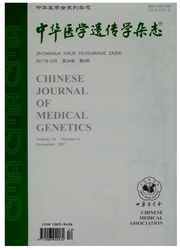

 中文摘要:
中文摘要:
目的建立稳定、准确、直观检测MJD1基因CAG三核苷酸重复的技术方法。方法应用重组DNA技术对中国大陆35例脊髓小脑性共济失调3型/马查多-约瑟夫病(spinocerebellar ataxia3/Machado-Joseph disease,SCA3/MJD)患者的MJD1基因CAG三核苷酸重复片段进行检测,并对测序结果进行CAG三核苷酸的多态性分析。结果35例SCA3/MJD患者MJD1基困CAG三核苷酸重复次数范围为65~81次,平均重复次数为(72.96±4.24)次。测序结果分析发现,所有的SCA3/MJD患者和大部分正常人MJD1基闪CAG三核苷酸重复序列包含两个CAA和一个AAG变异,在CAG三核苷酸重复序列末尾靠近3’端方向存在GGG/CGG的多态变化,GGG一般存在于CAG重复次数较少的正常人群,而CGG多存在于SCA3/MJD患者。结论重组DNA技术可以稳定准确、直观的检测MJD1基因的CAG三核苷酸重复次数,是诊断SCA3/MJD和分析CAG三核苷酸多态性主要的技术方法。
 英文摘要:
英文摘要:
Objective To establish a stable, accurate and intuitive method for detecting the CAG trinucleotide repeats of MJD1 gene. Methods The CAG trinucleotide polymorphism of the MJD1 gene was analyzed by recombinant DNA technology and DNA sequencing in 35 spinocerebellar ataxia 3/Machado Joseph disease(SCA3/MJD) patients from Mainland China. Results The range of the CAG repeat of the 35 patients was 65 81 (mean=72.96±4.24). The CAG repeats contained two CAAs and one AAG variations in the CAG motif in all the patients and majority of the healthy controls. There was a CGG/GGG polymorphism at the 3'end of the CAG repeat. The GGG allele was consistently associated with smaller CAG repeats in healthy controls. On the other hand, the CGG allele consistently existed in the patients. Conclusion Recombinant DNA technology can stably, accurately and intuitively detect the CAG trinucleotide repeat of the MJD1 gene. It should be used as a major technique to diagnose the SCA3/MJD and analyze the polymorphism of CAG sequence.
 同期刊论文项目
同期刊论文项目
 同项目期刊论文
同项目期刊论文
 Analysis of SCA2 and SCA3/MJD Repeats in Parkinson's Disease in Mainland China: Genetic, Clinical, a
Analysis of SCA2 and SCA3/MJD Repeats in Parkinson's Disease in Mainland China: Genetic, Clinical, a Receptor expression-enhancing protein 1 gene (SPG31) mutations are rare in Chinese Han patients with
Receptor expression-enhancing protein 1 gene (SPG31) mutations are rare in Chinese Han patients with Mutation Analysis of the TATA box-binding protein (TBP) gene in Chinese Han patients with spinocereb
Mutation Analysis of the TATA box-binding protein (TBP) gene in Chinese Han patients with spinocereb 期刊信息
期刊信息
